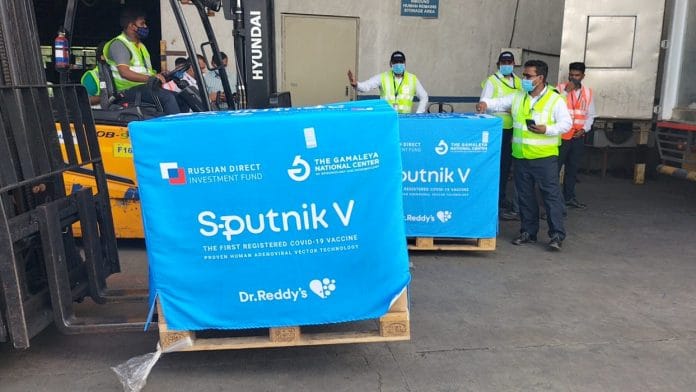New Delhi: The Sputnik V Covid-19 vaccine could become part of the national vaccination programme after July when the manufacturing of adequate doses begins in India, ThePrint has learnt.
The Russian-made vaccine is currently available only in the private sector and requires a storage temperature of -18 to -20 degrees Celsius, which is significantly less than the 2-8 degrees Celsius required for the two vaccines currently in the national programme — Covishield and Covaxin.
However, experts associated with the programme noted that the storage temperature should not be a deterrent.
“Currently there are some 1.5-2 lakh Sputnik vaccines that have been imported into the country, so they will mostly be available in the private sector. But it might come into the national programme post-July when the country is expecting massive manufacturing to start happening within the country. Then they can be given at all ages,” said Dr N.K. Arora, chairman of the Covid-19 working group of the National Technical Advisory Group on Immunisation and director of the INCLEN Trust.
“The vaccine needs to be stored at a temperature of -18 to -20 degrees but that is not a cause of concern because that is also the temperature at which the polio vaccine is stored. So the programme is geared. The only question is when it becomes available in sufficient doses,” Dr Arora told ThePrint.
The recent decision to extend the gap between two doses of Covisheld to 12-16 weeks was based on the recommendation of the working group headed by Arora.
Meanwhile, the CoWIN platform has already started to reflect Sputnik as a vaccine option.
Also read: 51 nations’ nod shows Sputnik transparency, Russian researchers reply to doubts raised in Lancet
Sputnik being procured through channels ‘other than GoI’
India is set to receive Sputnik V vaccines from Russia over the next three months. The vaccines will be available in tranches of 6 million, 10 million and 20 million doses (for 3 million, 5 million and 10 million individuals) in May, June and July, the Government of India told the Supreme Court recently.
These vaccines will be available in the “other than GoI” vaccine procurement channel which means that states or private hospitals can procure them but the Government of India will not.
Dr Reddy’s Laboratories, which is importing Sputnik V into India, recently announced a tie-up with Apollo Hospitals for the administration of the vaccine. Some state governments are also reaching out for Sputnik because of the massive supply constraints of both Covaxin and Covishield.
The domestic production of the Russian-made vaccine is expected to touch 1.2 crore doses per month by July 2021.
Also read: Covaxin works against Indian-origin variant, finds ICMR-Bharat Biotech in lab tests
Sputnik uses two different adeno vectors for two doses
The two doses of the Sputnik vaccine are to be administered at a gap of three weeks. Like Covishield, it too uses an adenovirus (a weakened common cold virus) as a vector to introduce some elements of the SARS-CoV-2 virus into the body to teach the immune system to identify it when a full blown viral infection is mounted.
However, what makes this vaccine different from Covishield is the fact that it uses two different adenoviruses as vectors for its two shots.
In a letter, published in The BMJ journal, Professor Hasan Mahmud Reza of the Department of Pharmaceutical Sciences, North South University, Bangladesh explained the difference between the Oxford-AstraZeneca vaccine, manufactured as Covishield in India, and Sputnik V.
“The technology employed in the development of Sputnik V vaccine is very similar to that used in the Oxford-AstraZeneca COVID-19 vectored vaccine except that Sputnik V was developed using two human adenoviral vectors while the Oxford–AstraZeneca vaccine was developed using chimpanzee adenoviral vector. To avoid any neutralizing effect of pre-existing adenovirus antibody as well as T helper cell response due to prior infection with adenovirus (Ad5) or prior use of Ad5 as a vector [5,6], the use of chimpanzee adenoviral vector seems to be more logical than use of two human adenoviral vectors (Ad5 and Ad 26),” Professor Reza said.
However, he added that two shots of vaccine with two different viral vectors have shown better immunity.
“Nonetheless, two shots of vaccine with two different viral vectors have been demonstrated to produce better immunity based on the concept that the same adenovirus vector used in second dose may be neutralised before exerting its assigned activity by the antibody generated after the first dose of immunisation,” Reza noted.
Vaccine tracking platform on the anvil
The onslaught of the second wave of the pandemic led to a record surge in cases and deaths across the country, making vaccination extremely critical.
However, several deaths of medical professionals in Delhi over the last few days, many of whom were fully vaccinated, has given rise to the possibility that a vaccine-escaping variant is on the prowl in the capital.
Dr Arora also did not deny the possibility and said that the ICMR (Indian Council of Medical Research) is all set to launch a vaccine tracking system that will look at the escape impact of vaccinations, breakthrough infections and also adverse events following immunisation (AEFI).
“Vaccine escape is a possibility that we are looking at not just in Delhi but across the country. We have to look at it as a generic issue. That is why this vaccine tracking platform will be very important,” he told ThePrint.
(Edited by Rachel John)
Also read: Antibody tests can’t measure Covid ‘immunity’. But this is how they can help you






